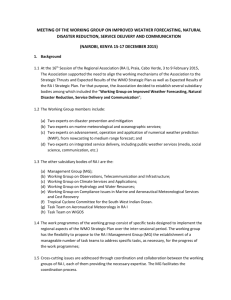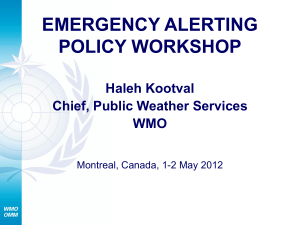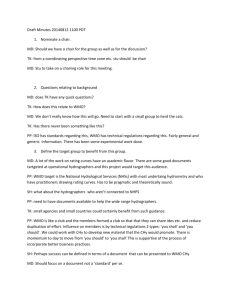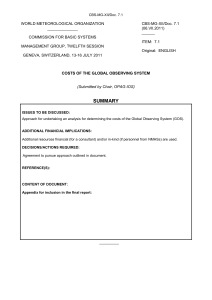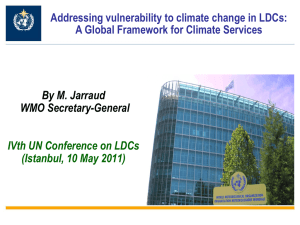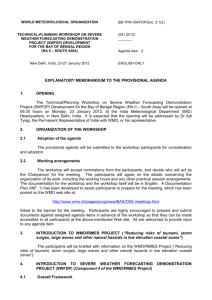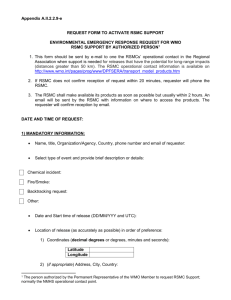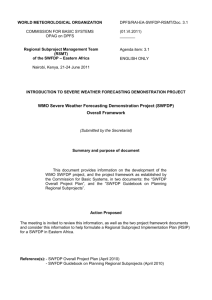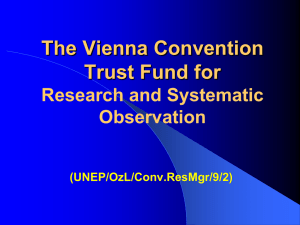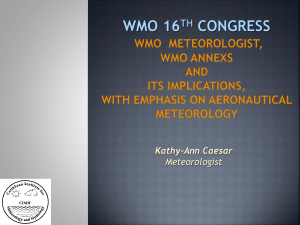Document
advertisement
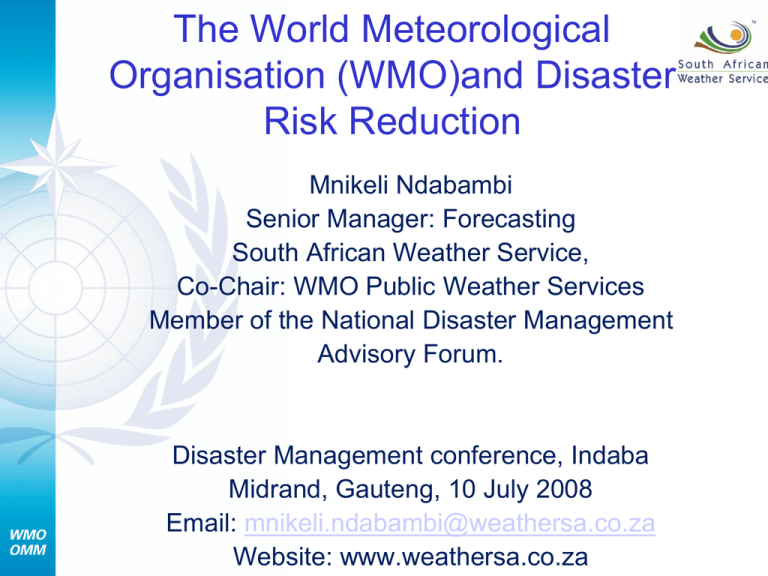
The World Meteorological Organisation (WMO)and Disaster Risk Reduction Mnikeli Ndabambi Senior Manager: Forecasting South African Weather Service, Co-Chair: WMO Public Weather Services Member of the National Disaster Management Advisory Forum. Disaster Management conference, Indaba Midrand, Gauteng, 10 July 2008 Email: mnikeli.ndabambi@weathersa.co.za Website: www.weathersa.co.za “Global Climate Change and its impact is possibly the greatest environmental challenge facing the world this Century “ 2 Distribution of natural disasters 1975-2001 • • • • • WMO: 80% of natural hazards are weather related. Natural hazards and disasters •Natural hazards become natural disasters when people’s lives and livelihoods are destroyed. •Human and material losses caused by natural disasters are a major obstacle to sustainable development. •By issuing accurate forecasts and warnings in a form that is readily understood and by educating people how to prepare against such hazards, before they become disasters, lives and property can be protected. WMO Disaster Risk Reduction Activities •They are integrated and coordinated with other international, regional and national organizations. •WMO coordinates the efforts of NMHSs (countries) to mitigate human and property losses, through improved forecast services and early warnings, as well as risk assessments, and by raising public awareness. WMO Disaster Risk Reduction Activities, continue •Emphasis is on disaster risk reduction: one dollar invested in disaster preparedness can prevent seven dollars’ worth of disaster-related economic losses—a considerable return on investment. •WMO’s objective is to reduce by 50 per cent, by 2019, the associated 10-year average fatality of the period 1994-2003 for weather-, climate- and water-related natural disasters. Public Weather Service Program (PWSP) in support of Disaster Risk Reduction •The Commission for Basic Systems (CBS) approved the World Weather Information Service (WWIS) and Severe Weather Information Centre (SWIC) to become operational components of the Public Weather Services Programme (PWSP). •These WMO websites were officially launched on 23 March 2005. PWSP in support of Disaster Risk Reduction, continue •In support of the Hyogo Framework which was adopted by 168 Governments in January 2005, •a survey was developed and conducted on WMO Members in 2006 with specific objectives:- Survey objectives , 1. To compile information on severe weather warning systems operated by Members with a view to publishing a handy reference on such system; 2. To assess the vulnerability of various Members to weather-related disasters with a view to developing workshops to address the gaps and weaknesses identified, and 3. To assess the PWS needs of National Meteorological and Hydrological Services with a focus on identifying opportunities to improve products and services, in particular, on severe weather warning services. Survey results •Survey results identified rain as the hazard of most concern. • 40% of the responses cited “forecasting accuracy” as the primary challenge, • WMO recommended enhancing the predictability of rain (as defined in this survey) as the most effective area to focus on to reduce the vulnerability of Member countries. WMO recommendations following survey results •Improve on the warning of short-term severe weather phenomena, especially rainstorms, nowcasting (short lead time) as a decision-support tool. •Workshops and capacity building on severe weather (emphasis on nowcasting- SAWS radar and Lightning Detection Networks are handy for nowcast). WMO recommendations following survey results, continue •The success of a warning is to change people’s behaviour hence education is the key issue. •Workshops and capacity building on reaching out to decision-makers as well as the public to help them understand the meaning of warnings and enhance their ability to translate these into action was considered.(Receive, in time, correct interpretation, appropriated action)….. Severe Weather Forecasting Demonstration Project (SWFDP) • WMO organised a series of subregional demonstration projects: –To improve severe weather forecast services in countries where sophisticated forecast systems not currently used (mostly developing countries) 13 • Principal focus on heavy rain and strong winds SWFDP goals • Main goals: – To improve technical ability of weather services – To improve lead-time of warnings – To improve the communication between global, regional and national meteorological centers (NMCs)-countries. – To improve interaction of NMCs with disaster management authorities before and during severe weather events. – To identify gaps for improvement. • First sub-regional project in Southeast Africa, from Nov 2006 to Nov 2007- (hosted by South African 14 Weather Service) Project key factors- (Learn trough doing) 15 • Low cost. • High impact. • Principal focus on heavy rain and strong winds • Usage of existing technology and forecasting processes by forecasters. • Cascading process of product dissemination. • Demonstrate results within a short period. • Continuous feedback on products and processes. Cascading process • Global centre send products to (Regional Specialised Meteorological Centre) RSMC-Pretoria • RSMC prepares guidance forecasts for next 5 days and disseminates daily to 5 NMCs • NMCs use guidance forecast in preparing warnings when appropriate to disaster management authorities UKMO ECMWF US NWS NMC NMC NMC NMC NMC 16 RSMC RSMC Improvements in delivering weather services through media Zimbabwe demonstrated news paper clips with Positive reports on usefulness of the forecast during Tropical Cyclone FAVIO:- Example of SWFDP products 17 Example of SWFDP RSMC Pretoria web site 18 SWFDP success areas Both Civil protection authorities and NMCs expressed improvements in terms of:• The timelines of severe weather information. • The relevance of the severe weather information for disaster management. • The significance of the information. • The credibility of the information. • The interaction between the Meteorological Services Department and Civil Protection 19 Departments SWFDP success areas, continue • Relationship and forecast perception by media. • The project is now part of SADC structure, Meteorological Association of Southern Africa(MASA), in the role out operational phase. (SAWS Secretariat of MASA). • Highly supported by the Executive Council, which is the decision making committee of WMO. 20 SWFDP success areas continue • WMO Public Weather Service Program is investigating training needs to support the role out, including Disaster Prevention and Mitigation aspects. 21 • South Africa as the country will now be part of the operational phase (SAWS, DPLG, UNOCHA, relief agencies and other emergency authorities or role players.(It has to be an integrated operation) Warnings distributed through hoax emails . • 07 October 2007 – Forecasters’ analysis, expected isolated severe thunderstorm from towards the evening of the 8th, the day after. – Print media journalist interviewed the forecaster telephonically, PM of 7th October. – Newspaper issued on the 8th with the distorted interview content (tornado at 5 PM today, etc). – Between 8-9 AM 8th October, telephones flooded the forecasting offices. 22 Warnings distributed through hoax emails continued---. • 08 October 2007 – It was discovered that there is hoax email from the member of the public, that interpreted the news paper warning content (also added spices, hurricane, tornado approaching Gauteng etc). – Forecast office issued press statement clarifying the warning (it was too late). – Internet jammed, telephones jammed…. – Total chaos at its best (Companies releasing employees). – Every car was on the street. 23 24 Lessons learned by SAWS . • Governments departments, companies and other organisations need to be engaged further, awareness campaigns need to be extended. • Enhance media education (+ve approach. • A need to know that the South African Weather Service is the sole provider of weather warnings, by law. Areas of improvement Weather, Climate and Water-sensitive decisions are made by millions of people each day.. Hence there is a need-> to bridge the gap between providers and users of weather, climate and water information as one of the focus area. [Media can be viewed both as users and providers (receive and disseminate)] 25 Prominent areas of weather and climate There is a need for a greater understanding of weather and climate including the nature of inherent variability and methods of coping with the projected impacts of climate change. There is more to gain from looking at climate and weather, not only as a hazards, but also as a “resources”. DRR structures should know, assess in quantitative terms and properly manage weather and climate resources for sustainable development. 26 It is clear that a fundamental change is required in the way weather and climate are viewed. Short-range Forecasting Long-range Forecasting NWP 3-Month Season Month Forecasting Period 14 Days 7 Days Outlook Guidance 2 Days Advisories Warnings 0–2 Hours Detail Warnings Systems Observations NWP Ensembles GCM & Ensembles -Satellite -Regional -Medium range -Ensembles -Ensembles -Statistical Models -Radar -Mesoscale -Ensembles -MOS -MOS GCM Ensembles -Lightning -Ensembles -ECMWF -Weather Data -UK model -MOS Forecast Uncertainty Research Programmes Seamless Integrated Weather Forecasting System Example of severe weather system in South Africa Tornado, school at Dullstroom,01 Aug2006 Floods, Glentana, S coast Philistown, De Aar 01 Aug 2006 Cut off low pressure system 01 August 2006 THANK YOU!!! Philipstown, De Aar, August 2006 Oops! The rain is pouring 29
